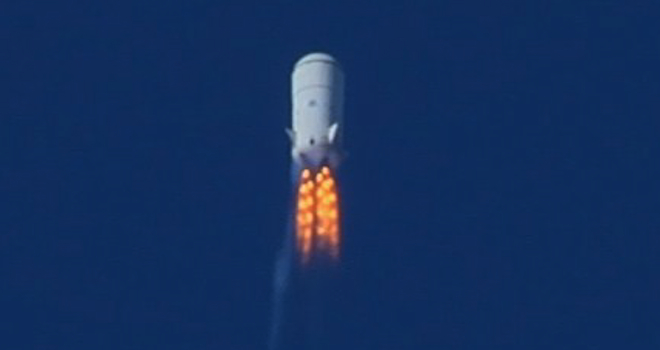Amazon.com Founder Jeff Bezos suffered a setback to his ambition to develop a robust private spaceflight business when an unmanned spacecraft developed by his company Blue Origin was destroyed on Aug. 24 shortly after takeoff in West Texas, the Wall Street Journal reports.
Locals described an immense and terrible explosion reminiscent of the 1986 Challenger disaster, according to a source on the ground in Van Horn, Texas, near the craft’s top secret launch site, Forbes reports.
The Forbes source described what happened on Aug. 24:
“Rumor has it that it just blew up, but we don’t have anything official,” a senior Culberson County, Texas civil servant told Forbes. “Blue Origin’s facility is remote — it’s about 30 or 4o miles from Van Horn.””People in town saw it and reported it, and posted it on Facebook,” added the official, who asked to remain anonymous for fear of repercussions. “One said it was just like the Challenger: an explosion, then a stream of smoke in the sky. They won’t tell us anything officially. This private space industry is so competitive and secretive.”
Debris were scattered around the desert region and was picked up for analysis by Blue Origin analysts, according to “government and industry officials,” cited by The Wall Street Journal.
The Journal emphasizes the enormous secrecy surrounding Blue Origin (the company didn’t even reveal its existence or plans to the public until three years after its founding in 2000), but today, Jeff Bezos himself took to the company’s blog to explain what happened to the experimental vertical takeoff and landing sub-orbital spacecraft, dubbed “The New Shepard” (after Alan Shephard, the first American and NASA astronaut in space.)
As Bezos put it:
Three months ago, we successfully flew our second test vehicle in a short hop mission, and then last week we lost the vehicle during a developmental test at Mach 1.2 and an altitude of 45,000 feet. A flight instability drove an angle of attack that triggered our range safety system to terminate thrust on the vehicle. Not the outcome any of us wanted, but we’re signed up for this to be hard, and the Blue Origin team is doing an outstanding job. We’re already working on our next development vehicle.
The billionaire entrepreneur also posted a series of photos of the craft in various stages of flight and on the ground, signing off with the salutation “Gradatim Ferociter!” That is Latin for “Step by Step, Courageously,” also Blue Origin’s motto.
He added: “P.S. In case you’re curious and wondering ‘where is the crew capsule,’ the development vehicle doesn’t have a crew capsule — just a close-out fairing instead.
“We’re working on the sub-orbital crew capsule separately, as well as an orbital crew vehicle to support NASA’s Commercial Crew program.”
Bezos, who founded Amazon.com in 1994, six years later founded Blue Origin, a commercial space exploration company that has been competing with several others for NASA funding to design reliable, reusable spacecraft that can be used to ferry cargo and astronauts to the International Space Station. The company has won $22 million and $3.7 million in two rounds of funding so far.
But Bezos’ ultimate aims are even grander: He wants to lower the cost of spaceflight and make the technology so reliable that ordinary people can take flights at a rate of one-voyage-per-week.
If you are up for that vision and have skills in aerodynamics engineering or similar fields, then you can head over to the company’s website and apply.
Currently, astronauts must ride to the station on Russian Soyuz vehicles, one of which crashed last week and may end up forcing the space station to be temporarily abandoned if the engineering problems aren’t sorted out before mid-November, when the current space station crew is due back on earth.









